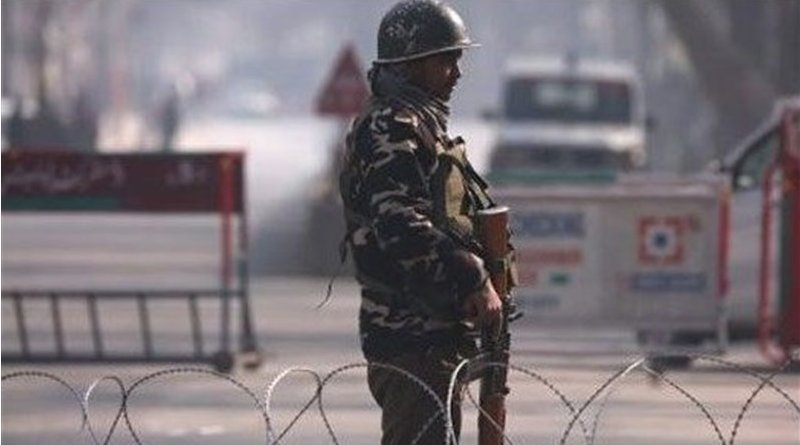The Permanence Of Chaos In Kashmir – Analysis
Official claims about the security situation in Jammu & Kashmir (J&K), especially since the August 2019 decision to abrogate Article 370 of the Indian Constitution, portray a vastly improved scenario. The Minister of State for Home Affairs Nityanand Rai has said that terrorist incidents have significantly reduced owing to the government’s “well-coordinated and multi-pronged strategy.”
The infiltration of terrorists from across the border, too, has reportedly reduced from 141 in 2019 to a meagre 14 in 2022. Till June this year, not a single terrorist could enter J&K due to the “approach adopted by Government of India to tackle cross-border infiltration,” the minister said. Officials in the J&K police department have further claimed that incidents of recruitment of local youth into terror groups have reduced from 143 in 2019 to only 30 in 2023 (till early September). The number of active terrorists in the region too has dropped from 250 in 2019 to a “double-digit figure.”
Against this backdrop—of an ecosystem favourable to the prevalence of peace—the encounter in Anantnag’s Gadul forests in Kokernag, between two terrorists belonging to the Lashkar-e-Taiba (LeT) and a very large number of security forces, that lasted for seven days (13-19 September) and resulted in the killing of four security force personnel including three officers, should come as a surprise to many. The encounter ended with the death of two terrorists, and only after the security establishment made substantial effort to subdue the terrorists. Sniffer dogs, drones and helicopters for surveillance as well as for offensive action, and substantial artillery power had to be used.
Actual battlefield challenges faced by the security forces are often beyond the purview and understanding of analysts and commentators. However, this task was made easy by media reports quoting officials who narrated the difficulties posed by well-trained and well-stocked terrorists, a challenging terrain, dense forests, and inclement weather. The terrorists used a vantage position on top of a mountain to their full advantage. It has also been stressed that security officials who followed an intelligence tip-off about the presence of terrorists in that location may have been led to a trap laid carefully by the terrorists.
The fact that all four casualties among the security forces occurred within the initial hours of the launch of the operation on 13 September subsequently constrained them into adopting a very cautious approach, thereby prolonging the encounter. The killing of senior security force officials must have come as a morale boost to the steadily declining fortunes of The Resistance Front (TRF), an offshoot of the LeT, which claimed responsibility for the attack. The protracted encounter invariably provided the terrorists with an opportunity to gather publicity, which appeared to be their secondary objective.
That the scale of terrorism and fatalities linked to it in Kashmir is at a historic low is not a matter of contention. However, what remains a matter of doubt is whether the momentum in dismantling the terrorist ecosystem can be maintained, or if the march toward peace will be periodically disrupted, thus making some amount of chaos more or less permanent. Security force establishments have blamed this on frequently shifting terrorist tactics, with expert input from Pakistan. The establishment of new outfits like the TRF, the use of hybrid terrorism, choosing soft targets among the minority Hindu and Sikh populations, and avoiding fortified urban centres for major attacks are among the tactics adopted by the terror formations. These have resulted in the terrorists being able to stage high-profile incidents, invariably involving the deaths of security forces.
At least 22 security force personnel have lost their lives in Kashmir this year, till 19 September. Although it portrays an improvement compared to last year in terms of net numbers, it is still an unacceptably high number vis-à-vis the 58 fatalities among the terrorists. An analysis of figures derived from the South Asia Terrorism Portal (SATP) reveals that the death ratio of security forces compared to that of terrorists is at a very high 0.38 this year, compared to the past several years. This indicates the death of more than one security force personnel along with three fatalities among the terrorists. The ratio was 0.16 in 2022, 0.23 in 2021, and 0.24 in 2020.
The other dominant trend is the terrorists’ ability to create new pockets of turbulence, which is surprising given the high concentration of security forces and the importance the government attaches to restoring peace in the region. Recent months have witnessed an uptick in terror attacks in the Pir Panjal region, comprising the Poonch and Rajouri districts. The Anantnag incident was accompanied by three other incidents of attempted infiltration and terror attacks in the adjoining areas. While the state of security in the valley areas may have been significantly reduced, the hills in the proximity of the Line of Control (LoC) remain a challenge.
On 17 September, the lieutenant governor of J&K vowed to avenge the deaths of the security force personnel killed in the Anantnag incident. On 27 September, the director general of police affirmed that the encounter did not disrupt peace in the region. On 15 September, district officials in Kupwara organised a candlelight vigil to pay tribute to the fallen officers. The march attracted a large and diverse crowd of people. This would have been unheard of in the past. Beyond the political positioning and ceremonial outreach, however, the state of terrorism in J&K continues to pose distinct challenges. Unless those are met, the region must brace for near permanence in the odd terror incident, which will try to poke holes in official claims of a durable peace.
This article was published at IPCS

